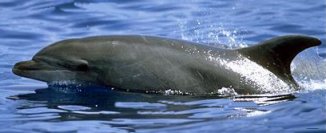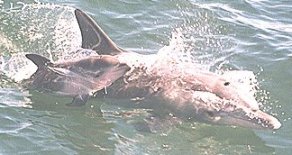 The bottlenose dolphin, or more commonly known just as a dolphin is a frequent visitor around our New Zealand coasts.
The bottlenose dolphin, or more commonly known just as a dolphin is a frequent visitor around our New Zealand coasts.
They are found in harbors,lagoons, bays, and estuaries. The dolphin also inhabit tropical and sub tropical waters throughout the world, and in the Pacific Ocean from north Japan down to Australia and across to California and down to Chile.
Dolphins are frequently seen rideing on the bow waves or the stern wakes of boats and larger ships.
Dolphins are active predators and eat a wide variety of fish, squids, and shrimps.
A dolphin pod sometimes encircles a large school of fish and herds them into a small, dense mass, sometimes using their tail flukes to stun the fish. The dolphins take turns charging through the school to feed. Or they herd schools of fish against a sand bar or shoreline to trap them in shallow water where they are eaten.
Dolphins do not chew their food. Usually they swallow fish whole head first, so the spines of the fish won't catch in their throats. They break larger fish by shaking them or rubbing them on the ocean floor.
Dolphins live in groups called pods. These pods are a long term social unit and comprises of around seven animals.These pods are also based largely on age, sex, and the reproductive condition of the animals. A common sight is mother and calf pairs and pods of mature females. A calf normally stays with its mother for three to six years.
Adult males are often observed alone or in pairs. These adult males commonly move between female groups in their range, and may pair up with females for brief periods.
Several pods may join together for short periods, up to a few hours to form larger groups.
Dolphins are thought to aid ill or injured pod mates. They may stand by and vocalize, or they may physically support the animal at the surface so it can breathe.
Some dolphin individuals regularly seek attention from us humans, such as touching and feeding.
A bottlenose dolphin has a snoutlike projection usually about 7-8 cm or 3 in long, marked by a lateral crease. The teeth are conical and interlocking designed for grasping (not chewing) food. Most animals have 20 to 25 teeth on each side of the upper jaw and 18 to 24 teeth on each side of the lower jaw.
Dolphins have a well developed acute sense of hearing. The specialized anatomy of a dolphins ear probably allows it to localize sounds under water effectively, a task that is difficult for humans.
Dolphins have sharp vision both in and out of the water. A dolphins eye is particularly adapted for seeing in water.
The bottlenose dolphin has a sleek, streamlined, spindle shaped body. Longitudinal muscles of the back and caudal peduncle (tail stalk) move flukes up and down to propel a dolphin through water. This enables the animal to swim very fast. They use their pectoral flippers mainly to steer and, with the help of the flukes to stop. (each lobe of the tail is called a fluke).
Flukes and the dorsal fin are flattened pads of a tough, dense, fibrous tissue, without muscle or bone.
The dorsal fin is often curved towards the back, and is located at the center of the back.
They are gray to gray green or gray brown colour on the back, fading to white on the belly, the lower jaw, and anal area. Some of the older dolphins sometimes show a spotting area along their sides and on their bellies.
This type of coloration I beleive is a camouflage, that may help conceal a dolphin from predators. When viewed from above a dolphin's dark back surface blends with the dark depths of the sea, and when seen from below a dolphins lighter belly blends with the bright surface.
On average full grown male dolphins are slightly longer than females, and considerably heavier, being able to grow to around 3.7 m or 12ft and weigh around 454 kgs or 1,000 lb. However the juvenile females grow at a faster rate until they reach to about 10 years of age.
On average females become sexually mature when they reach about 2.3 m or 7.5 ft, and are at about 5 to 12 years. Males become sexually mature when they reach about 2.4 to 2.6 m or 8-8.5 ft. and about 10 to 12 years of age.

Baby dolphins or calves are born in the water. The deliveries can be either tail or head first. The umbilical cord snaps during or soon after delivery.
Sometimes an assisting dolphin may stay close to the new mother and calf. This assisting dolphin can be male or female, and is often the only other dolphin a mother allows near her calf.
The dolphin calf is approximately 106-132 cm or 42 to 52in long and weighs about 20kg or 44 lbs. At this stage, just after the birth the dorsal fin and tail flukes are soft and pliable, but gradually become more and more stiff.
The young dolphins are normally darker than adults and show several light colored lines on their sides. These lines disappear within six months.
The baby dolphin calves nurse under the water close to the surface. These nursing instances usually lasts about five to ten seconds, and up to eight times a hour, 24 hours a day. This nursing may last for up to 18 months.
The dolphins mother stays close to her calf and directs its movements. The baby swims close to its mother and is carried in the mother's slip stream. This helps the calf to swim and enables the mother and calf to stay up with the pod group.